Booty, you have probably heard, is in the eye of the beholder.
Ask Jack Warner. Haitian officials complained that the lion’s share of US$750m—sent to Warner-controlled accounts by Fifa and a presidential candidate for the world governing body—never made it to the impoverished island, who were desperate for relief after a 7.0 earthquake in 2010.
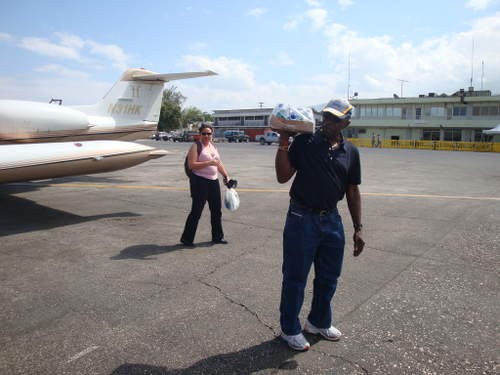
Haitian football authorities say Warner did not pass on most of the money donated to them during the humanitarian crisis.
(Copyright Concacaf)
Or ask David John-Williams. If Mark Bassant’s account is accurate, there were probably not inconsiderable sums of Fifa/ TTFA money stashed away in a bank account in Panama.
Or ask former PNM minister John O’Halloran. Or former Pan Trinbago president Arnim Smith.
That is why I am not at all optimistic about the chances of success of Prime Minister Dr Keith Rowley’s proposed initiative to attempt to resurrect club cricket in Trinidad and Tobago and the region.
Opting for a euphemistic formulation, as politicians are wont to do, particularly in election season, he was careful to avoid the word. But ‘resurrect’ is le mot juste.
“The sport of cricket now,” the current chairman of the Caricom Sporting Committee declared in Palo Seco on 28 July 2023, “is not what it used to be in our territories.”
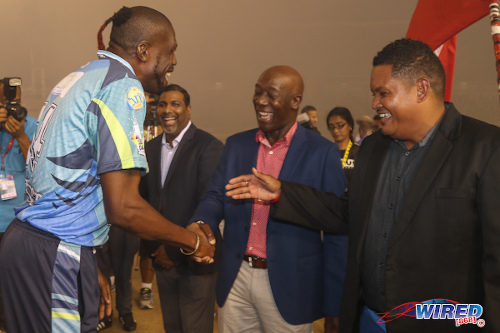
(Copyright Sean Morrison/ Wired868)
He never cited Tony Cozier, whose name Lloyd Best insisted years ago had to be first one on any list of all-time West Indies greats.
Listen, if you dare, to Danny Morrison and Daren Ganga and their current female co-commentators on the television. Or read what, since Cozier’s passing, has been passing for cricket reports and commentary in the regional press.
Is Best’s meaning not crystal clear? If, with Cozier, we could barely keep our heads above water—T20 World Cup victory in 2012 and the triple in 2016—what are our chances of survival in his absence?
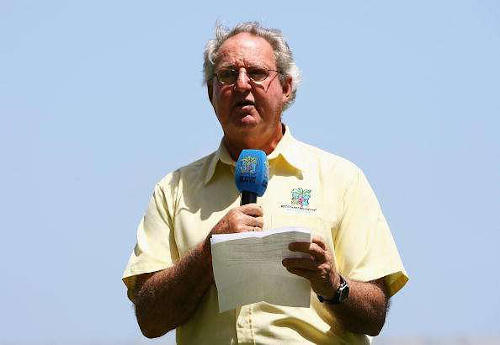
(via Sportskeeda)
Dr Rowley cited CLR James’ Beyond a boundary, in which the author describes the good old days when cricket ruled the roost in Port-of-Spain’s Queen’s Park Savannah.
Politician that he is, he deliberately declined to mention the graveyard that, day in day out nowadays, the once bustling hub of local club cricket has become. The little cemetery the Peschiers left near the racetrack all those many years ago has now expanded outwards to envelop the entire 250+ acres.
That story of mass retreat, shrinkage, abandonment is replicated in many areas around the country. The Honeymoon Savannah in Tunapuna is an example I know well.
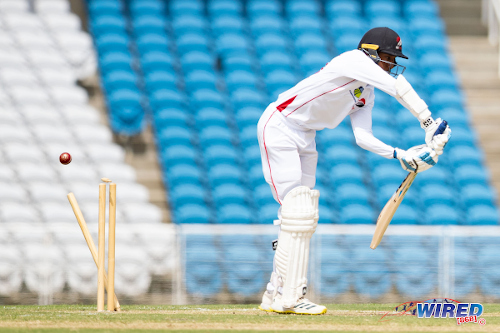
(Copyright Daniel Prentice/ Wired868)
The PM takes no responsibility for any of that. Nor did he take, on the day after Rohit Sharma’s India had humiliated Shai Hope’s home side in the first ODI, any responsibility for the regional side’s abject recent performances.
Indeed, he deemed it appropriate to take a sideswipe at today’s players, saying that “[h]olding a bat and wearing a gold chain will not preserve our legacy.”
And wishing to further distance himself from the mediocrity on display, he announced that he is “not in charge of West Indies cricket”.
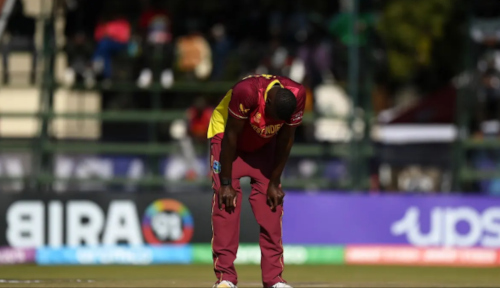
(Copyright ICC/ Getty)
Vaneisa Baksh doubtless rejoiced at that news. In her column, which appeared in Wired868 the next day, the columnist sang the praises of Barbados Prime Minister Mia Mottley.
The cricket historian told the story of how she happened to tune in on the live broadcast of Mottley’s address to the 22nd annual Sir Frank Worrell Memorial Lecture at the Cave Hill Campus.
Baksh was, she revealed, well pleased with the excellence of PM Mottley’s presentation. The good lady “has a vision for true development, and (…) is decisive and intrepid, unafraid to chart new courses.”
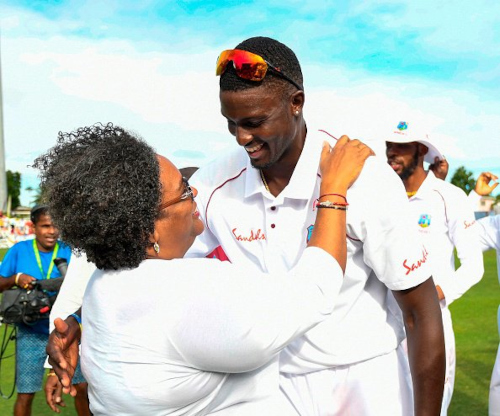
Photo: CWI Media
Moreover, we learn, Mottley was moved almost to tears on Tuesday by the discovery that only 600 tickets had been sold for Thursday’s first ODI. She decreed forthwith that her government would pay for some 1,500 schoolchildren to see both games in Barbados.
“Which other prime minister,” Baksh inquired rhetorically, “has ever made such a spontaneous gesture?”
“[I]f there should ever come a time when this moribund community should truly try to pull itself together again,” she gushed, “Mia Mottley is the obvious choice for leadership.”
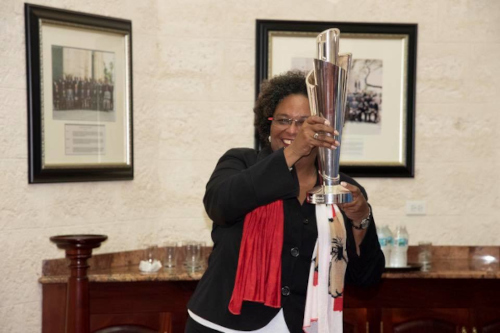
Well, maybe. But Dr Rowley has clearly given some thought to the question of how cricket in his own country—and, by extension, in the region—might be improved.
Presumably long in gestation, his initiative, which alas! qualifies more as ‘plan’ than ‘gesture,’ lacked the spontaneity Baksh seems to hold so dear.
Dr Rowley proposed to do rather more than ensuring that a couple thousand schoolchildren see two ODI matches. He told his audience he intends to provide, for three years in the first instance, “not insignificant grants to encourage the creation and sustenance of club cricket in Trinidad and Tobago.”
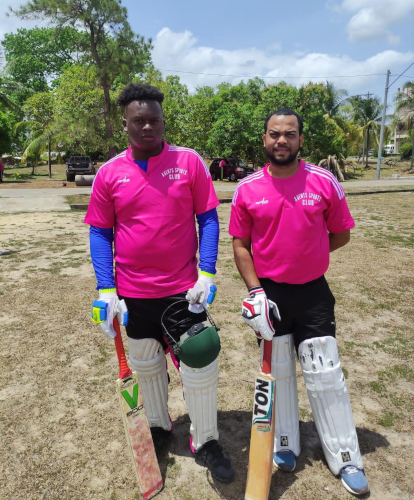
Photo: Agents Sports Club
He proposed to ask the Finance Minister to create a generous fund to support domestic cricket. One focus, it seems, will be on training and qualifying—and incentivising—officials and administrators through, inter alia, The UWI’s Sports Management programme.
According to the PM: “the intention is to encourage more young people at the primary school level into secondary school and into post-secondary school and create a foundation and increase the management capabilities at the club level and hope that will flow upwards in the sport.”
Education did not speak at the function. Sport and Community Development did. The PM must know he can reasonably expect little help from that source.
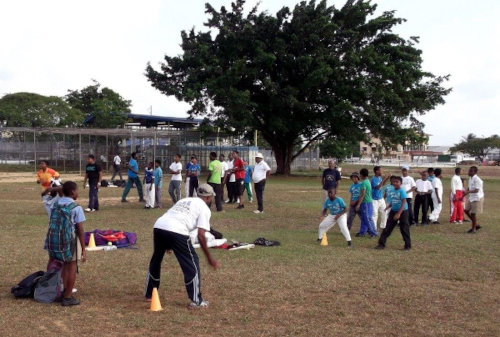
(via Fulham Sports Club)
So has he taken the time to examine the root causes of the rot which manifests as sub-standard performance on the field of play? Has he grasped the scale of the problem he is committing to tackle?
Does he really think that throwing government money at the problem has any chance of solving it?
It is a valid question. Elections, after all, as Baksh took the trouble to point out, are just around the corner—it’s the season of glad tidings and grand promises.
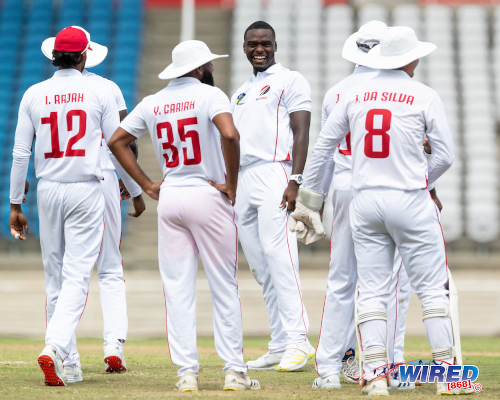
Photo: Daniel Prentice/ Wired868
The simple reason is that administrators cannot make durable clubs out of nothing; membership, pre-dating the club, throws up those who will run it. Ask Merry Boys’ Patrick Rampersad. Or Morvant Caledonia’s Jamaal Shabazz. Or Eddie Hart. Or Keith Look Loy.
A more complete picture might have been had by speaking to W Connection’s DJW. But we shall have to settle for La Horquetta Rangers’ Richard Ferguson or Joe Public’s Jack Warner.
Which brings us back to where we began. Government’s direct injections of funds into sport are rarely investments; they most often constitute—or are perceived as—largesse, freeness, a handout, at least potentially, booty.
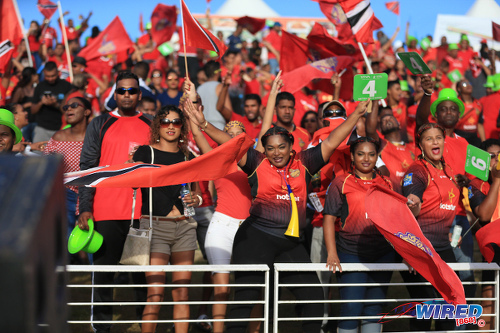
(Copyright Allan V Crane/ CA-Images/ Wired868)
And, in T&T if not elsewhere in the region, beholders have big, bulging eyes. Thus, they are often better able to see that there is more than one meaning to the verb ‘to help oneself’.
Earl Best taught cricket, French, football and Spanish at QRC for many years and has written consistently for the Tapia and the Trinidad and Tobago Review since the 1970’s.
He is also a former sports editor at the Trinidad Guardian and the Trinidad Express and is now a senior lecturer in Journalism at COSTAATT.
 Wired868 Wired868 for smart sport news and opinion
Wired868 Wired868 for smart sport news and opinion

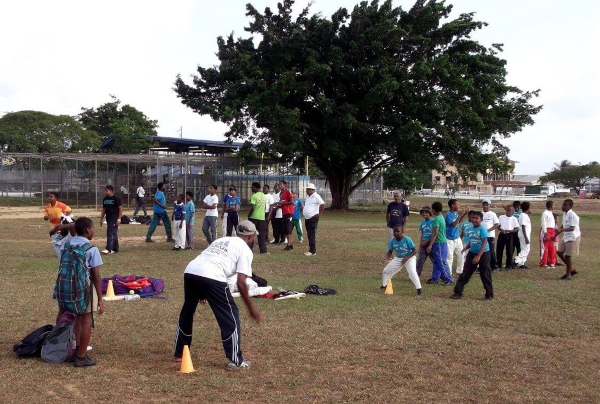



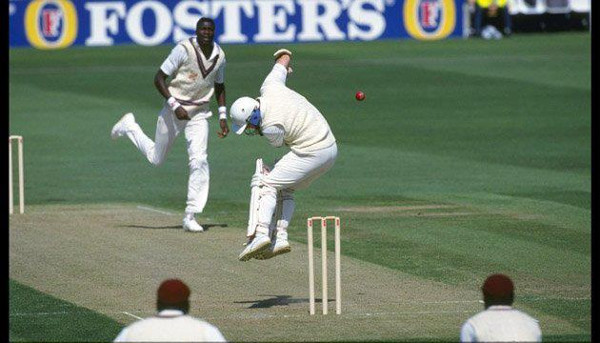

This is not a gentle rap on the knuckles; it is a surgical severing of both wrists—not with a scalpel but with a 3-canal!
It reminds me of my all-time favourite Peanuts cartoon.
Charlie Brown, Lucy, Schroeder and Linus are lying on a grassy knoll, looking up at the clouded sky.
“What do you see in the clouds?” asks Linus.
First to respond, Lucy discusses the stoning of some saint in the bible.
Next up, Schroeder predictably draws parallels with something in Beethoven’s life.
The third-last frame features a pregnant silence.
“What do YOU see,” prompts Linus in the penultimate frame, “in the clouds, Charlie Brown?”
“Well,” comes the response, “I was going to say I see a ducky and a horsie but…”
Our sport administrators are more interested in hugging the limelight and the resources of these sporting bodies. The on-field results are quite clear to see. Typical case in point is the rise of ‘rising sun’ coinciding with the dessimation of local soccer. Some of the youths who they are proposing to “load up the matic on and empty the clip” might have had a brighter future if that money was used in developing grassroot programs (to the benefit of many) rather than investing in a political career (to surround yourself with a selfish, greedy, ‘racially inclusive’, ‘honest’ few) then being unceremoniously dumped in the end.
Great observations and analyses, as usual, by Earl Best.
One point comes to my mind that I haven’t seen addressed. It may be that I have not been following cricket administration matters as closely as I should, given what the game has given me.
When West Indies ruled the roost, we had the same formula that the current top teams deploy – fast (and I mean FAST) bowlers and aggressive batsmen.
For those and to suit our batting style, we need fast wickets.
At the test level, we were superlative at Kingston and Bridgetown. It’s almost embarrassing to see what passes for a West Indian test wicket in Barbados now.
In TT, we had a slower wicket at the oval, but most of our players grew up on the hard and fast clay based, matting covered wickets of the QPS and other grounds around the country.
Soil science has come a long way. Starting with Kerry Packer’s WSC, cricket wicket turfs are being routinely grown to specification in controlled environments and moved to site.
India seems to have used the science to their advantage. England and Australia have been doing it for decades.
Before spending money on training administrators, we may be better off building the foundations on which the game is based – investing in groundsmen, playing fields, wickets, practice nets and facilities managers (so that teams can share grounds and play games without having the cost and responsibility of maintaining a ground alone.)
Then the required investment in youth and community cricket will have a chance to produce the impact we seek.
Your point about the need for good grounds and trained groundsmen is well taken. But WI will go nowhere even with the best grounds and groundsmen in the world if we have no PLAYERS.
The primary focus, therefore, has to be on stuff that not only encourages but makes it possible for ordinary young people to play cricket. When we were playing almost three decades ago, the price of cricket equipment was already prohibitive.
But you can still practise every day AND play football for a club if you own a single pair of boots.
And you can play basketball competitively and sweat as often as you like in the sneakers you wear to school. Or to lime.
Don’t fool your fat, cricket’s biggest problem is MONEY. But not only in the sense of how much it costs to play the game.
I hope to flesh that out in Part 2.
Earl Best, I agree entirely with your point that the primary focus must be getting more people to play the game. The larger the pool, the better chance we have of unearthing talent. As you rightly say, there are barriers to entry that have to be overcome.
My earlier comments seek to make the case that better wickets and facilities will enhance and support the player pipeline and help reverse the decline of TTO’s and WI’s cricket. While that is not all that’s needed, it can provide a much needed catalyst for the turn around.
For success and sustainability in a competitive environment, all endeavours (whether business, sport, arts, culture, professions or otherwise), organizations, industries and countries need to approach talent management in a comprehensive manner.
To get new players, there must be a programme to first make more youth aware of the game, then make it attractive to them (that’s what fast wickets can do.) Only when we have their attention do we have a realistic chance to engage them in playing. Even the most avid supporters don’t find the current game as played by our teams to be attractive. With the retirement of the pioneering class of greats, WI T20 too is in rapid decline.
As in business, beyond attracting and engaging talent, players must be trained and developed to improve and adequately incentivised, so as to be retained. The form and level of incentives must reflect the level and nature of competition. A point that needs to be explored some more.
My point in focusing on wickets, was to target one part of the talent management spectrum, aiming for more immediate benefits. If the game isn’t attractive now, getting new talent becomes more difficult.
True and fast wickets make for attractive cricket.
Given the quality and performance of the current crop of players, there may even be an existential threat to the game we so love. Given what it means to people in the Caribbean, should better wickets not be a place to start the revival?
We have to work on the whole gamut, but as the pipeline of new talent is rapidly shrinking, we have to work on and help those already playing the game. My suggestion is targeted at this group, at all levels. That way we immediately help the crop in line to succeed the current batch of top players, as well as those who are earlier along the development curve.
Beyond players, we have to apply the same philosophy for improving and sustaining the other inputs and supporting infrastructure – facilities, equipment, technology and communication.
Talent management in professional sport as a business has to be taken beyond the players and administrators to the supporting cast of professional analysts, reporters and broadcasters. It’s embarrassing to find out that only 600 tickets were pre-sold for a recent game against India, the #1 team in the world. Where were the marketing and promotion professionals?
All of these require funding, which will come only if the providers see benefits for themselves. That’s another discussion.